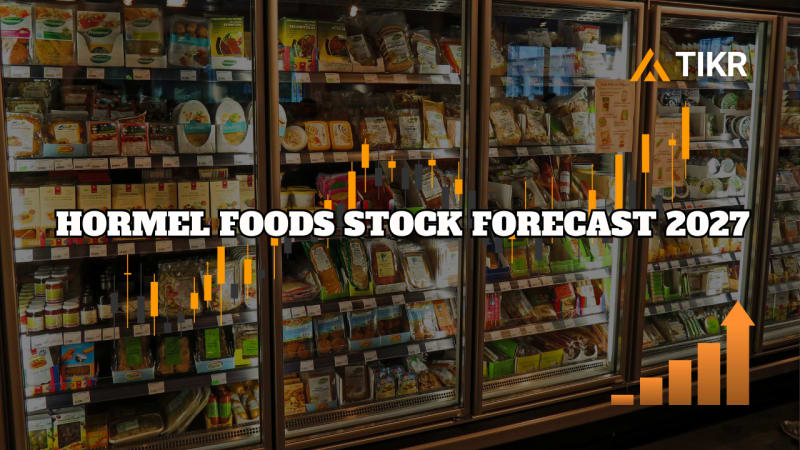Hormel Foods Corporation (NYSE: HRL) has faced a difficult year. The stock trades near $25/share, down roughly 21% over the past 12 months, as weaker demand, lower pricing, and higher costs have weighed on results. Still, the company’s steady brands and strong balance sheet have helped cushion the decline.
Recently, Hormel has focused on improving efficiency and protecting profitability amid a tough operating environment. The company continues to invest in its key brands and streamline parts of its supply chain to offset higher costs. Management also maintained its long-running record of dividend payments, underscoring confidence in the company’s ability to generate stable cash flow over time.
With modest growth returning and earnings expected to stabilize, analysts see limited but steady upside ahead.
Unlock our Free Report: 5 AI compounders that analysts believe are undervalued and could deliver years of outperformance with accelerating AI adoption (Sign up for TIKR, it’s free) >>>
Analyst Price Targets Suggest Modest Upside
Hormel trades near $25/share today. The average analyst price target is $29/share, implying about 17% upside over the next year. Forecasts are closely grouped, showing cautious sentiment across Wall Street:
- High estimate: ~$34/share
- Low estimate: ~$25/share
- Median target: ~$29/share
- Ratings: 1 Buy, 3 Outperforms, 6 Holds, 1 Underperform, 1 Sell
For investors, that tight range suggests modest expectations. The market seems to believe most of Hormel’s near-term challenges are already reflected in the stock. If cost pressures ease and volume trends stabilize, the company could modestly outperform, but a major rally looks unlikely in the short term.

See analysts’ growth forecasts and price targets for Hormel Foods (It’s free!) >>>
Hormel Foods: Growth Outlook and Valuation
Hormel’s outlook points to stability rather than fast growth:
- Revenue is projected to grow about 2–3% annually through 2027
- Operating margins are expected to stay around 9%
- Shares trade at roughly 17x forward earnings, slightly below long-term averages
- Based on analysts’ average estimates, TIKR’s Guided Valuation Model using a 16.6x forward P/E suggests about $30/share by 2027
- That represents roughly 21% total upside, or about 10% annualized returns
For investors, this means Hormel could deliver steady, income-driven returns rather than rapid capital gains. The stock’s valuation looks fair, supported by its strong balance sheet and reliable dividend. Hormel’s case rests on margin recovery and disciplined execution, offering a slow but predictable compounding story for patient investors.

Value stocks like Hormel Foods in as little as 60 seconds with TIKR (It’s free) >>>
What’s Driving the Optimism?
Hormel’s brand portfolio remains one of the strongest in the packaged foods industry. Well-known names like Spam, Skippy, and Jennie-O continue to anchor its shelf presence and pricing power, even as consumer demand has softened.
Easing input costs and ongoing productivity initiatives are helping margins recover from recent lows. Management’s focus on simplifying operations and paying down debt supports long-term stability.
For investors, these factors suggest Hormel has the financial flexibility to maintain dividends, rebuild profitability, and gradually restore confidence in its fundamentals.
Bear Case: Slow Growth and Competitive Pressures
Even with these positives, Hormel’s growth profile remains subdued. Volume trends have been weak, and demand for processed meats and pantry staples has slowed. Private-label competition continues to rise as consumers seek cheaper alternatives.
At the same time, while valuation has improved, it still depends on steady execution. If cost inflation returns or pricing momentum fades, earnings could stall again. For investors, the risk is that Hormel remains stuck in a low-growth cycle, limiting upside potential despite its defensive appeal.
Outlook for 2027: What Could Hormel Be Worth?
Based on analysts’ average estimates, TIKR’s Guided Valuation Model suggests Hormel could trade near $30/share by 2027, representing about 21% total upside, or roughly 10% annualized returns.
That outlook reflects gradual earnings recovery and modest sales growth, not a major turnaround. To deliver stronger returns, Hormel would need to surprise on cost efficiency or margin expansion.
For investors, the takeaway is clear: Hormel offers income stability and limited downside, but only moderate upside. It fits best for dividend portfolios seeking dependable returns rather than rapid growth.
AI Compounders With Massive Upside That Wall Street Is Overlooking
Everyone wants to cash in on AI. But while the crowd chases the obvious names benefiting from AI like NVIDIA, AMD, or Taiwan Semiconductor, the real opportunity may lie on the AI application layer where a handful of compounders are quietly embedding AI into products people already use every day.
TIKR just released a new free report on 5 undervalued compounders that analysts believe could deliver years of outperformance as AI adoption accelerates.
Inside the report, you’ll find:
- Businesses already turning AI into revenue and earnings growth
- Stocks trading below fair value despite strong analyst forecasts
- Unique picks most investors haven’t even considered
If you want to catch the next wave of AI winners, this report is a must-read.
Click here to sign up for TIKR and get your free copy of TIKR’s 5 AI Compounders report today.

